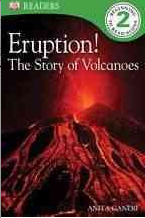Another Literary Analysis by Keenan
Citation/Bibliography Entry
Ganeri, Anita. Eruption: The Story of Volcanoes. New York: DK Publishing, 2000.
Reliability
I find this publisher, DK Publishing, to be reliable because this book is included in the DK Reading program and is designed in conjunction with Dr. Linda Gambrell who is a distinguished Professor of Education. Dr. Gambrell has served as the President of the National Reading Conference, The College Reading Association, and the International Reading Association. DK Reader books are guaranteed to capture a readers interest, develop their reading skills, apply knowledge, and generate a love of reading.
Category
The category of this book is informational pattern. There is a lot of information about volcanoes and how they are created and how and why they erupt. Volcanoes start off underground, where it seems like they are solid and hard, but inside the earth it is so hot that the rocks melt and create lava. When volcanoes erupt, they shoot ash, dust, and lava out of the crater that acts like a vent. When a volcano stops erupting, the crater then fills with water and becomes a lake or a dry, grassy plain. This nonfiction book tells information about the world.
Short Annotation
This non-fiction book about volcanoes describes, in words and vibrant pictures, how volcanoes are made and how they erupt. This 32-page book, written from the second person point of view, has great facts and pictures about volcanoes and how they erupt. Recommended for readers 7-10 years old.
Point of View: second person
- “…you jump up and down…” (6).
- “You can walk around the streets…” (20).
- “…you can’t seem…” (26).
Tense: Past
- “They will blast…” (12).
- “…they will poke up…” (26).
- “…they will erupt!” (28).
Literary Excellence
- Alliteration:
- “…fiery fountains…” (9).
- “…steep sides.” (10).
- “…called a crater…” (14).
- “…because it always bursts…” (15).
- “…sea started…” (27).
- Appositives:
- “…red-hot.” (8).
- “…cone-shaped…” (10).
- “Lava, ash, and dust…” (14).
- “…build roads, bridges, and houses.” (23).
- “…brand-new…” (27).
- “…crushed-up…” (29).
- Assonance:
- “…cools…” (8).
- “…oozes…” (11).
- Consonance:
- “…erupt…” (30).
- “…fields…” (12).
- Irony:
- “…erupt quietly…” (11).
- Personification:
- “…spits out fire.” (4).
- “…makes it hiss…” (29).
- Powerful Verbs:
- “…with a BANG!” (4).
- “…Extinct volcanoes…” (16).
Connection: text to self and text to world
This book reminds me of a time when I went to Maui, which is one of the Hawaiian Islands. When I was in Maui, we saw a non-active volcano and it was extremely high up and you could see the crater filled with dark green vegetation. We drove up to the top of the crater and the oxygen level was low because I found it harder to breath. When we were at the top, I imagined what it would look like when it was erupting long ago. This non-fiction picture book made me remember my thoughts as I stood at the top of the non-active volcano wondering what it was like active.
This book reminds me of the many active volcanoes around the world today. There are about 1500 potentially active volcanoes worldwide. About 50 to 70 of these volcanoes actively erupt each year and at any given time, including today, there are about 20 volcanoes erupting. Some only erupt with ash and steam coming out of the top as the lava flows underground, and others erupt with fierce violent bursts of lava erupting over the sides and down the mountain slopes. Volcanoes have been active in history, as well as around the world today.

